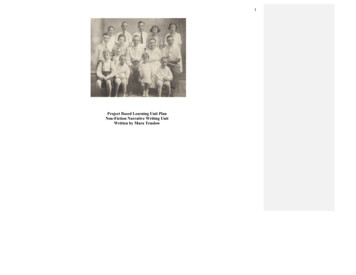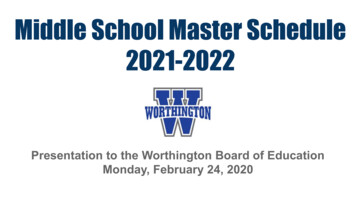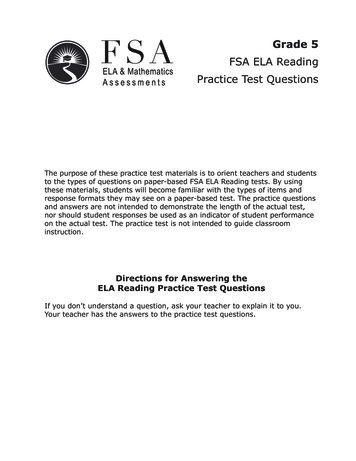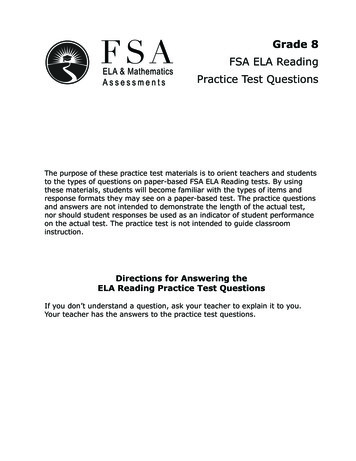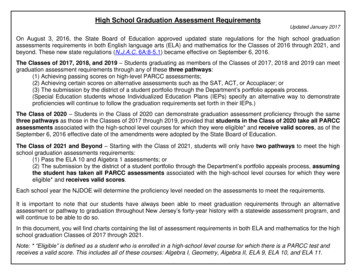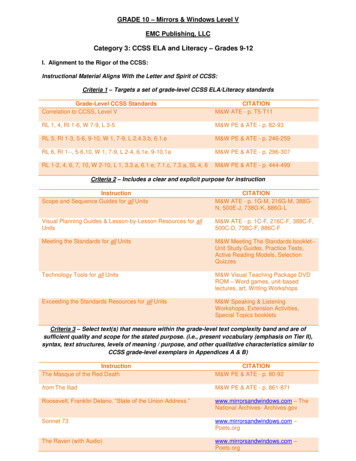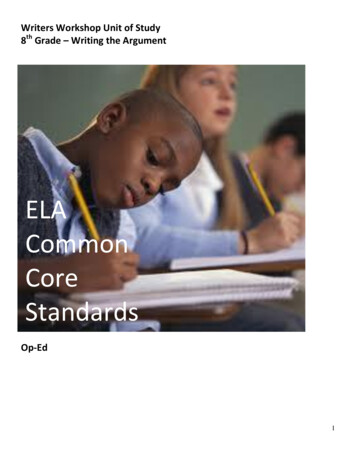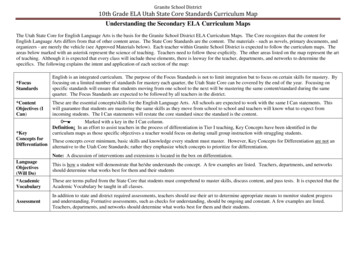
Transcription
Granite School District10th Grade ELA Utah State Core Standards Curriculum MapUnderstanding the Secondary ELA Curriculum MapsThe Utah State Core for English Language Arts is the basis for the Granite School District ELA Curriculum Maps. The Core recognizes that the content forEnglish Language Arts differs from that of other content areas. The State Core Standards are the content. The materials - such as novels, primary documents, andorganizers - are merely the vehicle (see Approved Materials below). Each teacher within Granite School District is expected to follow the curriculum maps. Theareas below marked with an asterisk represent the science of teaching. Teachers need to follow these explicitly. The other areas listed on the map represent the artof teaching. Although it is expected that every class will include these elements, there is leeway for the teacher, departments, and networks to determine thespecifics. The following explains the intent and application of each section of the map:*FocusStandardsEnglish is an integrated curriculum. The purpose of the Focus Standards is not to limit integration but to focus on certain skills for mastery. Byfocusing on a limited number of standards for mastery each quarter, the Utah State Core can be covered by the end of the year. Focusing onspecific standards will ensure that students moving from one school to the next will be mastering the same content/standard during the samequarter. The Focus Standards are expected to be followed by all teachers in the district.*ContentObjectives (ICan)These are the essential concepts/skills for the English Language Arts. All schools are expected to work with the same I Can statements. Thiswill guarantee that students are mastering the same skills as they move from school to school and teachers will know what to expect fromincoming students. The I Can statements will restate the core standard since the standard is the content.Marked with a key in the I Can column.Definition: In an effort to assist teachers in the process of differentiation in Tier I teaching, Key Concepts have been identified in thecurriculum maps as those specific objectives a teacher would focus on during small group instruction with struggling students.*KeyConcepts forThese concepts cover minimum, basic skills and knowledge every student must master. However, Key Concepts for Differentiation are not anDifferentiation alternative to the Utah Core Standards; rather they emphasize which concepts to prioritize for differentiation.Note: A discussion of interventions and extensions is located in the box on differentiation.LanguageObjectives(Will Do)This is how a student will demonstrate that he/she understands the concept. A few examples are listed. Teachers, departments, and networksshould determine what works best for them and their students*AcademicVocabularyThese are terms pulled from the State Core that students must comprehend to master skills, discuss content, and pass tests. It is expected that theAcademic Vocabulary be taught in all classes.AssessmentIn addition to state and district required assessments, teachers should use their art to determine appropriate means to monitor student progressand understanding. Formative assessments, such as checks for understanding, should be ongoing and constant. A few examples are listed.Teachers, departments, and networks should determine what works best for them and their students.
Granite School District10th Grade ELA Utah State Core Standards Curriculum Map“In Tier 1 instruction all students receive high quality, differentiated culturally responsive core academic and behavioral instruction through thegeneral education program.” (GSD MTSS Common Vocabulary) Differentiation in the secondary classroom includes both intervention andextension. Secondary ELA teachers are expected to differentiate for all students’ needs.DifferentiationInterventions – Interventions are those supplemental procedures put in place to help the struggling student. A few examples are listed.Teachers, departments, and networks should determine what works best for them and their students.Note: The Keys for differentiation are only intended for those students who struggle the most. Interventions are intended for the largergroup needing a variety of different learning experiences to meet all of the expected standards.Extensions – Extensions are adaptions made for the advanced learner. Advanced learners need differentiation in instruction toguarantee growth. It is expected that differentiation for these students meet individual needs. A few examples are listed. Teachers,departments, and networks should determine what works best for them and their students.The choice of vehicle for teaching a skill is to be determined by the teacher, department, and/or network within the parameters of the approvedmaterials. The Granite School District approved texts for secondary classes are:Holt Elements of Literature and Holt Elements of LanguageMYAccess! (Writing)*ApprovedMaterialsApproved Novels List (Novels List) - All lengthy pieces of work used in either whole group or small group instruction, both fiction and nonfiction, must be approved through the designated process. Following is a statement from the board policy on novels:“Teacher ChargeIt is important to note that any lengthy work, fiction or non-fiction, used in whole group or small group (such as literary circles) must befrom the Granite District Approved Novels List.In addition to only using novels from the approved list, teachers must also use their best judgment (considering lexile levels, interest levels,State Core standards, individual community standards and student need) in choosing materials from the approved list for their classes.”Notes:Additional Resources: It is recognized that there are many great resources that can enhance teaching. Examples: Safari Montage, USOE Digital Textbooks,State Core Appendices, State Writing Rubrics, State Close Reading Rubrics, UEN performance tasks and lesson plans, the Teaching Channel, otherExercise extreme caution when using sources not on the official Approved Materials list. It is the responsibility of the teacher to ensure that anything used in classor required of students is appropriate for the purpose, students, and community. Always read the material thoroughly before using them with students.Teachers must also keep in mind that any lengthy piece of work from any source must first be on the novels list before being used in class or in small group.Department and Network Alignment: Departments and networks are advised to align materials, such as novels, both at grade level and vertically, to avoidduplication and to keep communication open with departments and with feeder schools. It is also advisable for schools to create a reference guide for teachers thatidentify books, ideas, and resources available at the school.
Granite School District10th Grade ELA Utah State Core Standards Curriculum MapFOCUS STANDARDS OVERVIEW - Refer to the Utah State Core Standards for complete standard and grade level expectationQtr1Reading LiteratureRL.9-10.1 Cite textual evidence, (explicitly andinferences)RL.9-10.2 Identify details that support centralideas or themes. Summarize text.RL.9-10.3 Analyze complex characters and theirchange over time.RL.9-10.4 Analyze words and phrases thatimpact meaning and tone.Reading Informational TextRI.9-10.1 Cite textual evidence,(explicitly and inferences)RI.9-10.2 Identify details thatsupport central ideas or themes.Summarize.RI.9-10.3 Analyze complexcharacters and their change overtime.RI.9-10.4 -Analyze words andphrases that impact meaning andtone.2RL.9-10.1 Cite textual evidence, (explicitly andinferences)RL.9-10.3 Analyze complex characters and theirchange over time.RL.9-10.4 Analyze words and phrases thatimpact meaning and tone.RI.9-10.8 Evaluate claims andarguments for sufficiency and validreasoning.RI.9-10.9 Analyze seminaldocuments of historic value.WritingReview of Writing ProcessW.9-10.4 Produce writing with appropriateorganization, development, and styleW.9-10.5 Revise and edit through planning and tryinga new approach.W.9-10.6 Use technology (e.g. electronic portfolio,blogs, message boards, discussion boards) to displayinformation flexibly.SL.9-10.1 Participate incollaborative discussions byreading and researching thetopic.Argument WritingW.9-10.1 Write arguments analyzing substantivetopics or texts, while clarifying relationships amongclaims.W.9-10.7 Conduct research and synthesize informationfrom multiple sources.LanguageL.9-10.2 Demonstratecommand of capitalization,spelling, semicolon, andcolon.SL.9-10.2 Present with diversemedia after evaluatingaccuracy and credibility of thesource.L.9-10.4 Determinemeanings for words andphrases through contextand utilization of structuralchanges, (e.g., parts ofspeech).SL.9-10.4 Present informationappropriate to task, audience,and purpose such that listenerscan follow reasoning anddevelopment.L.9-10.3 Understand howlanguage functions indifferent contexts andutilize MLA format forEnglish.SL.9-10.6 Adapt speech to avariety of contexts and tasks,demonstrating command offormal English.L.9-10.6 Utilize academicvocabulary accurately.SL.9-10.5 Select digital mediato enhance understanding,L.9-10.3 Understand howlanguage functions indifferent contexts andutilize MLA format forEnglish.L.9-10.1 Utilize parallelstructure.W.9-10.10 Write routinely over short and extendedtime frames.W.9-10.8 Integrate information to establish flowamong multiple sources.RL.9-10.9 Analyze how an author draws on andtransforms source material.Speaking/Listening.W.9-10.9 Draw evidence from literary andinformational text to support analysis and reflection.34RL.9-10.1 Cite strong and evidence,Informational Writing/Research SkillsW.9-10.2 Write informative/explanatory text witheffective transitions, complex ideas, appropriateformatting and supporting details.RL.9-10.3 Analyze how complex charactersdevelop over the course of a text.RI.9-10.6 Cite details or examplesof the point of view or culturalexperiences.RL.9-10.6 Analyze a point of view or culturalexperience reflected in a work of literatureRI.9-10.7 Analyze same subject intwo mediums for emphasisRL. 9-10.7 Analyze the representation of asubject or a key scene in two different artisticmedium.RI.9-10.10 Read and comprehendnonfiction at the 9-10 textcomplexity level.W.9-10.8 Integrate information to establish flowamong multiple sources.RL.9-10.10 Read and comprehend literature atthe high end of the grades 9–10 text complexityband independently and proficiently.W.9-10.9 Draw evidence from literary andinformational text to support analysis and reflection.RL.9-10.3 Analyze complex characters and theirchange over time.RI.9-10.5 Analyze the use andeffects of text structure (parallelplots, flashbacks, pacing)Narrative WritingW.9-10.3 Write coherent narratives from multiplepoints of view.SL.9-10.3 Evaluate speaker’spoint of view and reasoning forfallacies and use of rhetoric.RI.9-10.6 Cite details or examplesof the point of view or culturalexperiences.W.9-10.10 Write routinely over short and extendedtime frames.SL.9-10.4 Present informationappropriate to task, audience,and purpose such that listenerscan follow reasoning anddevelopment.RL.9-10.5 Analyze the use and effects of textstructure (parallel plots, flashbacks, pacing)RL.9-10.6 Cite details or examples of the point ofview or cultural experiences.W.9-10.7 Conduct research and synthesize informationfrom multiple sources.L.9-10.5 Analyze the roleof figurative language andnuances in word meanings.
Granite School District10th Grade ELA Utah State Core Standards Curriculum MapQUARTER 1Quarter 1 - Focus Standards (Essential Concepts)Reading Literature RL.9-10.1 Cite strong and thorough textual evidence to support analysis of what the text says explicitly as well as inferences drawn from the text.RL.9-10.2 Determine a theme or central idea of a text and analyze in detail its development overthe course of the text, including how it emerges and is shaped and refined by specific details;provide an objective summary of the text.RL.9-10.3 Analyze how complex characters (e.g., those with multiple or conflicting motivations)develop over the course of a text, interact with other characters, and advance the plot or developthe theme.RL.9-10.4 Determine the meaning of words and phrases as they are used in the text, includingfigurative and connotative meanings; analyze the cumulative impact of specific word choices onmeaning and tone (e.g., how the language evokes a sense of time and place; how it sets a formal orinformal tone).Reading Informational Text RI.9-10.1 Cite strong and thorough textual evidence to support analysis of what the text says explicitly as well as inferences drawn from the text.RI.9-10.2 Determine a central idea of a text and analyze its development over the course of thetext, including how it emerges and is shaped and refined by specific details; provide an objectivesummary of the textRI.9-10.3 Analyze how the author unfolds an analysis or series of ideas or events, including theorder in which the points are made, how they are introduced and developed, and the connectionsthat are drawn between them.RI.9-10.4 - Determine the meaning of words and phrases as they are used in a text, includingfigurative, connotative, and technical meanings; analyze the cumulative impact of specific wordchoices on meaning and tone (e.g., how the language of a court opinion differs from that of anewspaper).Content ObjectivesI can statements: I can determine themeand/or central idea.(RL.9-10.2, RI.9-10.2) I can analyze characters.(RL.9-10.3) I can use context to findthe meanings of wordsand phrases. (RL.910.4, RI.9-10.4) I can analyze how anauthor presentsinformation forpurpose. (RI.9-10.3) I can write using correctorganization and stylefor my task andaudience. (W.9-10.4) I can use the writingprocess to strengthenmy writing. (W.9-10.5)Writing – Review of writing process W.9-10.4 Produce clear and coherent writing in which the development, organization, and style are appropriate to task, purpose, and audience. (Grade-specific expectations for writing types aredefined in standards 1–3 above.)W.9-10.5 Develop and strengthen writing as needed by planning, revising, editing, rewriting, ortrying a new approach, focusing on addressing what is most significant for a specific purpose andaudience. (Editing for conventions should demonstrate command of Language standards 1–3 up toand including grades 9–10 on page 61.)W.9-10.6 Use technology, including the Internet, to produce, publish, and update individual orshared writing products, taking advantage of technology’s capacity to link to other in- formationand to display information flexibly and dynamically.W.9-10.10 Write routinely over extended time frames (time for research, reflection, and revision)and shorter time frames (a single sitting or a day or two) for a range of tasks, purposes, andaudiencesI can use text evidence.(RL.9-10.1, RI.9-10.1)I can use technology togather texts, producewriting, andcommunicate withpeers. (W.9-10.6)Language ObjectivesI will statements:Note: Use teacher anddepartmentalcollaboration todetermine specific I willstatements for yourclass and school.Example: I will read“Story of an Hour,” andanalyze its meaning,citing textual evidenceto support my claims.Academic Vocabulary EvidenceSufficient evidenceTextual ConnotativemeaningsCumulative impacton toneCumulative impacton meaningFigurative meaningObjective summaryContextCentral ideaConceptFlow of ideasDenotation
Granite School District10th Grade ELA Utah State Core Standards Curriculum MapSpeaking/Listening SL.9-10.1 Initiate and participate effectively in a range of collaborative discussions (one-on-one, in groups, and teacher-led) with diverse partners on grades 9–10 topics, texts, and is- sues, buildingon others’ ideas and expressing their own clearly and persuasively.a. Come to discussions prepared having read and researched material under study; explicitlydraw on that preparation by referring to evidence from texts and other research on the topic orissue to stimulate a thoughtful, well-reasoned exchange of ideas.b. Work with peers to set rules for collegial discussions and decision-making (e.g., in- formalconsensus, taking votes on key issues, presentation of alternate views), clear goals anddeadlines, and individual roles as needed.c. Propel conversations by posing and responding to questions that relate the current discussionto broader themes or larger ideas; actively incorporate others into the discussion; and clarify,verify, or challenge ideas and conclusions.d. Respond thoughtfully to diverse perspectives, summarize points of agreement anddisagreement, and, when warranted, qualify or justify their own views and understanding andmake new connections in light of the evidence and reasoning presented.SL.9-10.2 Interpret information presented in diverse media and formats (e.g., visually,quantitatively, orally) and explain how it contributes to a topic, text, or issue under study. I can writeappropriately to a rangeof both short andextended tasks. (W.910.10) I can collaborate withothers effectively andappropriate to task.(SL.9-10.1) I can analyzeinformation presentedin media formats. (SL.910.2)Language L.9-10.2 Demonstrate command of the conventions of standard English capitalization, punctuation, and spelling when writing.a. Use a semicolon (and perhaps a conjunctive adverb) to link two or more closely relatedindependent clauses.b. Use a colon to introduce a list or quotation.c. Spell correctly.L.9-10.4 . Determine or clarify the meaning of unknown and multiple-meaning words and phrasesbased on grades 9–10 reading and content, choosing flexibly from a range of strategies.a. Use context (e.g., the overall meaning of a sentence, paragraph, or text; a word’s position orfunction in a sentence) as a clue to the meaning of a word or phrase.b. Identify and correctly use patterns of word changes that indicate different meanings or parts ofspeech (e.g., analyze, analysis, analytical; advocate, advocacy).c. Consult general and specialized reference materials (e.g., dictionaries, glossaries, thesauruses),both print and digital, to find the pronunciation of a word or deter-mine or clarify its precisemeaning, its part of speech, or its etymology.d. Verify the preliminary determination of the meaning of a word or phrase (e.g., by checking theinferred meaning in context or in a dictionary).AssessmentsState and district mandated assessment.Examples: SRI, Benchmarks, SAGEOthers as determined at classroom, department, andnetwork level. Examples: Formative assessments determined by teacherWriting to demonstrate writing process, includingrevision.I can correctly spell,punctuate, andcapitalize. (L.9-10.2) I can use context andother strategies todetermine and clarifyword meaning. (L.910.4)InterventionsDetermined at classroom, department, and networklevel. Examples: Adjust length of required writing Adjust vocabulary and text complexity Explicit teaching of Tier Two academic language Cooperative learning Teacher mentoringExtensionsDetermined at classroom, department, and networklevel. Examples: Adjust text complexity Recommendation for honors placement Departmental electives Project-based learning Cross-curricular project-based learningFor lesson design help, see Approved Materials and Additional Resources from page 2.
Granite School District10th Grade ELA Utah State Core Standards Curriculum MapQUARTER 2Quarter 2 - Focus Standards (Essential Concepts)Reading Literature RL.9-10.1 Cite strong and thorough textual evidence to support analysis of what the textsays explicitly as well as inferences drawn from the text.RL.9-10.3 Analyze how complex characters (e.g., those with multiple or conflictingmotivations) develop over the course of a text, interact with other characters, and advancethe plot or develop the theme.RL.9-10.4 Determine the meaning of words and phrases as they are used in the text,including figurative and connotative meanings; analyze the cumulative impact of specificword choices on meaning and tone (e.g., how the language evokes a sense of time andplace; how it sets a formal or informal tone).RL.9-10.9 Analyze how an author draws on and transforms source material in a specificwork (e.g., how Shakespeare treats a theme or topic from Ovid or the Bible or how a laterauthor draws on a play by Shakespeare).Content ObjectivesI can statements:I can cite textual evidence.(RL.9-10.1) I can analyze characterdevelopment. (RL.9-10.3) I can analyze how wordsimpact meaning. (RL.9-10.4) I can analyze how an authoruses source material. (RL.910.9) I can evaluate an argumentfor validity. (RI.9-10.8) I can analyze U.S. documentsfor literary significance. (RI.910.9)Reading Informational Text RI.9-10.8 Delineate and evaluate the argument and specific claims in a text, assessingwhether the reasoning is valid and the evidence is relevant and sufficient; identify falsestatements and fallacious reasoning.RI.9-10.9 Analyze seminal U.S. documents of historical and literary significance (e.g.,Washington’s Farewell Address, the Gettysburg Address, Roosevelt’s Four Freedomsspeech, King’s “Letter from Birmingham Jail”), including how they address related themesand concepts.Writing – Argument Writing W.9-10.1 Write arguments to support claims in an analysis of substantive topics or texts,using valid reasoning and relevant and sufficient evidence.a. Introduce precise claim(s), distinguish the claim(s) from alternate or opposing claims,and create an organization that establishes clear relationships among claim(s),counterclaims, reasons, and evidence.b. Develop claim(s) and counterclaims fairly, supplying evidence for each while pointingout the strengths and limitations of both in a manner that anticipates the audience’sknowledge level and concerns.c. Use words, phrases, and clauses to link the major sections of the text, create cohesion,and clarify the relationships between claim(s) and reasons, between reasons andevidence, and between claim(s) and counterclaims.d. Establish and maintain a formal style and objective tone while attending to the normsand conventions of the discipline in which they are writing.e. Provide a concluding statement or section that follows from and supports theargument presented.W.9-10.7 Conduct short as well as more sustained research projects to answer a question(including a self-generated question) or solve a problem; narrow or broaden the inquirywhen appropriate; synthesize multiple sources on the subject, demonstrating understanding of the subject under investigation.W.9-10.8 Gather relevant information from multiple authoritative print and digital sources,using advanced searches effectively; assess the usefulness of each source in answering theresearch question; integrate information into the text selectively to maintain the flow ofideas, avoiding plagiarism and following a standard format for citation.I can write clear, wellsupported arguments usingclaims, evidence, andcounterclaims. (W.9-10.1)I can conduct taskappropriate research andsynthesize information frommultiple sources. (W.9-10.7) I can evaluate and useresearch effectively andethically. (W.9-10.8) I can draw evidence fromtexts to support analysis,reflection, and research.(W.9-10.9)Language ObjectivesI will statements:Note: Use teacher anddepartmentalcollaboration todetermine specific I willstatements for yourclass and school.Example: I will write acharacter analysis citingspecific evidence fromthe text to show howthe author’s word choiceimpacts thedevelopment of thatcharacter.Academic Vocabulary Claim Counterclaims Opposing claim Relevant evidence Alternate claim Citation Line of reasoning Valid reasoning Editing Revising Style manual Seminaldocuments Integrate Rhetoric Substance Advocate,advocacy Coherent Formal MLS style Multiple plot lines Parallel plots
Granite School District10th Grade ELA Utah State Core Standards Curriculum MapWriting – Argument Writing - Continued W.9-10.9 Draw evidence from literary or informational text to support analysis, reflection,and research.a. Apply grades 9–10 Reading Standards to literature (i.e., “Analyze how an author drawson and transforms source material in a specific work [e.g., how Shakespeare treats atheme or topic from Ovid or the Bible or how a later author draws on a play byShakespeare]”).b. Apply grades 9–10 Reading Standards to literary nonfiction (i.e., “Delineate andevaluate the argument and specific claims in a text, assessing whether the reasoning isvalid and the evidence is relevant and sufficient; identify false statements and fallaciousreasoning”).W.9-10.10 Write routinely over extended time frames (time for research, reflection, andrevision) and shorter time frames (a single sitting or a day or two) for a range of tasks,purposes, and audiences. I can write appropriate to arange of tasks. (W.9-10.10) I can present informationorally that is clear and logicalto task. (SL.9-10.4) I can use appropriatelanguage in both formal andinformal circumstances.(SL.9-10.6) I can use correct formattingin a variety disciplines andwriting types. (L.9-10.3) I can use language (academicand domain specific)effectively. (l.9-10.6)Speaking/Listening SL.9-10.4 Present information, findings, and supporting evidence clearly, concisely, andlogically such that listeners can follow the line of reasoning and the organization,development, substance, and style are appropriate to purpose, audience, and task.SL.9-10.6 Adapt speech to a variety of contexts and tasks, demonstrating command offormal English when indicated or appropriate. (See grades 9–10 Language Standards 1 and3 on pages 61 for specific expectations.)Language L.9-10.3 Apply knowledge of language to understand how language functions in differentcon- texts, to make effective choices for meaning or style, and to comprehend more fullywhen reading or listening.a. Write and edit work so that it conforms to the guidelines in a style manual (e.g., MLAHandbook, Turabian’s Manual for Writers) appropriate for the discipline and writingtype. L.9-10.6 Acquire and use accurately general academic and domain-specific words andphrases, sufficient for reading, writing, speaking, and listening at the college and careerread ness level; demonstrate independence in gathering vocabulary knowledge whenconsidering a word or phrase important to comprehension or expression.AssessmentsState and district mandated ned at classroom, department, and networkDetermined at classroom, department, and networklevel.level. SRI, Benchmarks, SAGEExamples:Examples:Others as determined at classroom, department, and Adjust length of required writing Adjust text complexitynetwork level. Examples: Adjust vocabulary and text complexity Recommendation for honors placement Formative assessments determined by teacher Explicit teaching of Tier Two academic language Departmental electives Written narrative with central idea, dialogue, and Cooperative learning Project-based learningmultiple points of view. Teacher mentoring Cross-curricular project-based learningFor lesson design help, see Approved Materials and Additional Resources from page 2.
Granite School District10th Grade ELA Utah State Core Standards Curriculum MapQUARTER 3Quarter 3 - Focus Standards (Essential Concepts)Reading Literature RL.9-10.1 Cite strong and thorough textual evidence to support analysis of whatthe text says explicitly as well as inferences drawn from the text.RL.9-10.3 Analyze how complex characters (e.g., those with multiple orconflicting motivations) develop over the course of a text, interact with othercharacters, and advance the plot or develop the theme.RL.9-10.6 Analyze a particular point of view or cultural experience reflected in awork of literature from outside the United States, drawing on a wide reading ofworld literature.RL. 9-10.7 Analyze the representation of a subject or a key scene in twodifferent artistic medium, including what is emphasized or absent in eachtreatment.RL.9-10.10 By the end of grade 10, read and comprehend literature, includingstories, dramas, and poems, at the high end of the grades 9–10 text complexityband independently and proficiently.Reading Informational Text RI.9-10.6 Determine an author’s point of view or purpose in a text and analyzehow an author uses rhetoric to advance that point of view or purpose.RI.9-10.7 Analyze various accounts of a subject told in different mediums,determining which details are emphasized in each account.RI.9-10.10 By the end of grade 10, read and comprehend literary nonfiction atthe high end of the grades 9–10 text complexity band independently andproficiently.Writing – Informational Writing W.9-10.2 Write informative/explanatory texts to examine and convey complexideas, concepts, and information clearly and accurately through the effectiveselection, organization, and analysis of content.a. Introduce a topic; organize complex ideas, concepts, and information to makeimportant connections and distinctions; include formatting (e.g., headings), graphics(e.g., figures, tables), and multimedia when useful to aiding comprehension.b. Develop the topic with well-chosen, relevant, and sufficient facts, extendeddefinitions, concrete details, quotations, or other information and examplesappropriate to the audience’s knowledge of the topic.c. Use appropriate and varied transitions to link the major sections of the text, createcohesion, and clarify the relationships among complex ideas and concepts.d. Use precise language and domain-specific vocabulary to manage the complexity of thetopic.e. Establish and maintain a formal style and objective tone while attending to the normsand conventions of the discipline
Granite School District 10th Grade ELA Utah State Core Standards Curriculum Map FOCUS STANDARDS OVERVIEW - Refer to the Utah State Core Standards for complete standard and grade level expectation Qtr Reading Literature Reading Informational Text Writing Speaking/Listening Language 1 RL.9-10.1 Cite textual evidence, (explicitly and inferences) RL.9-10.2 Identify details that support central



